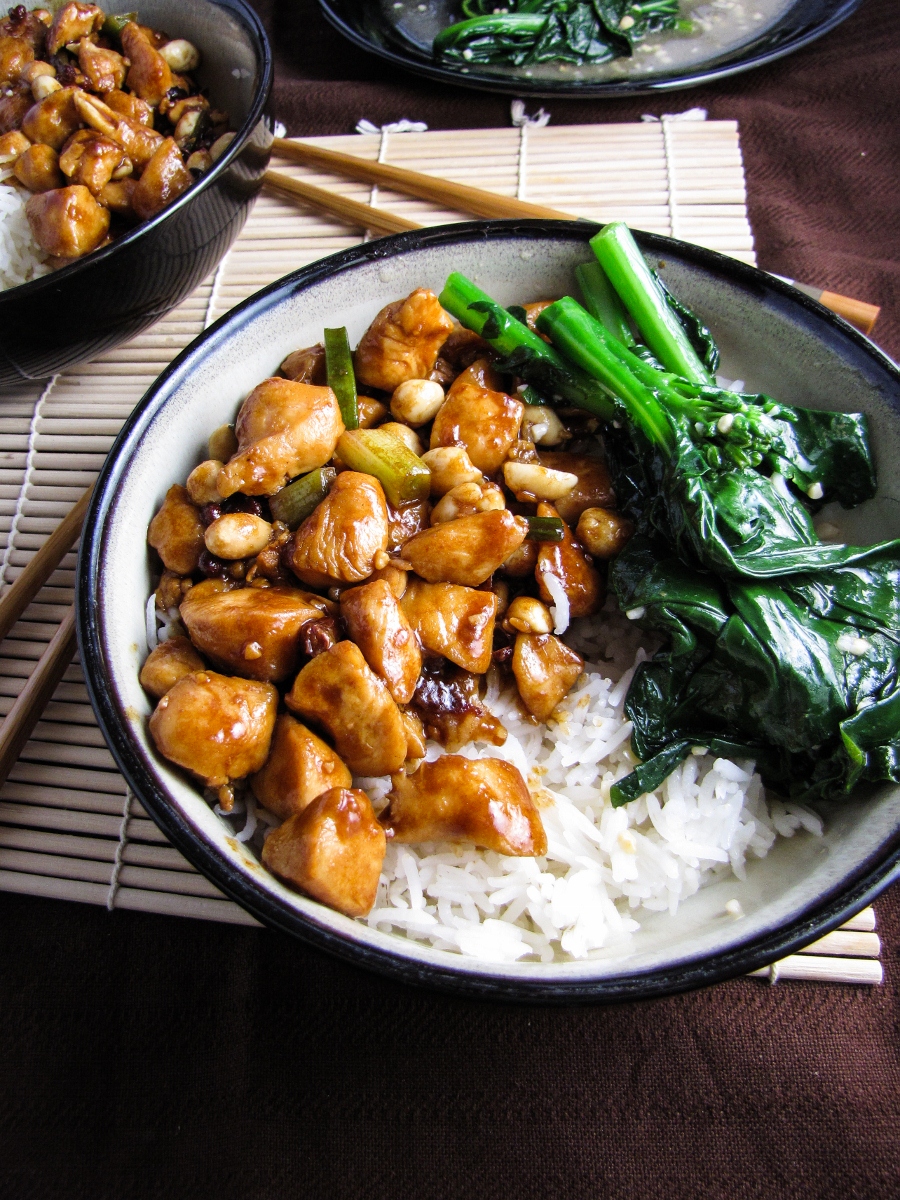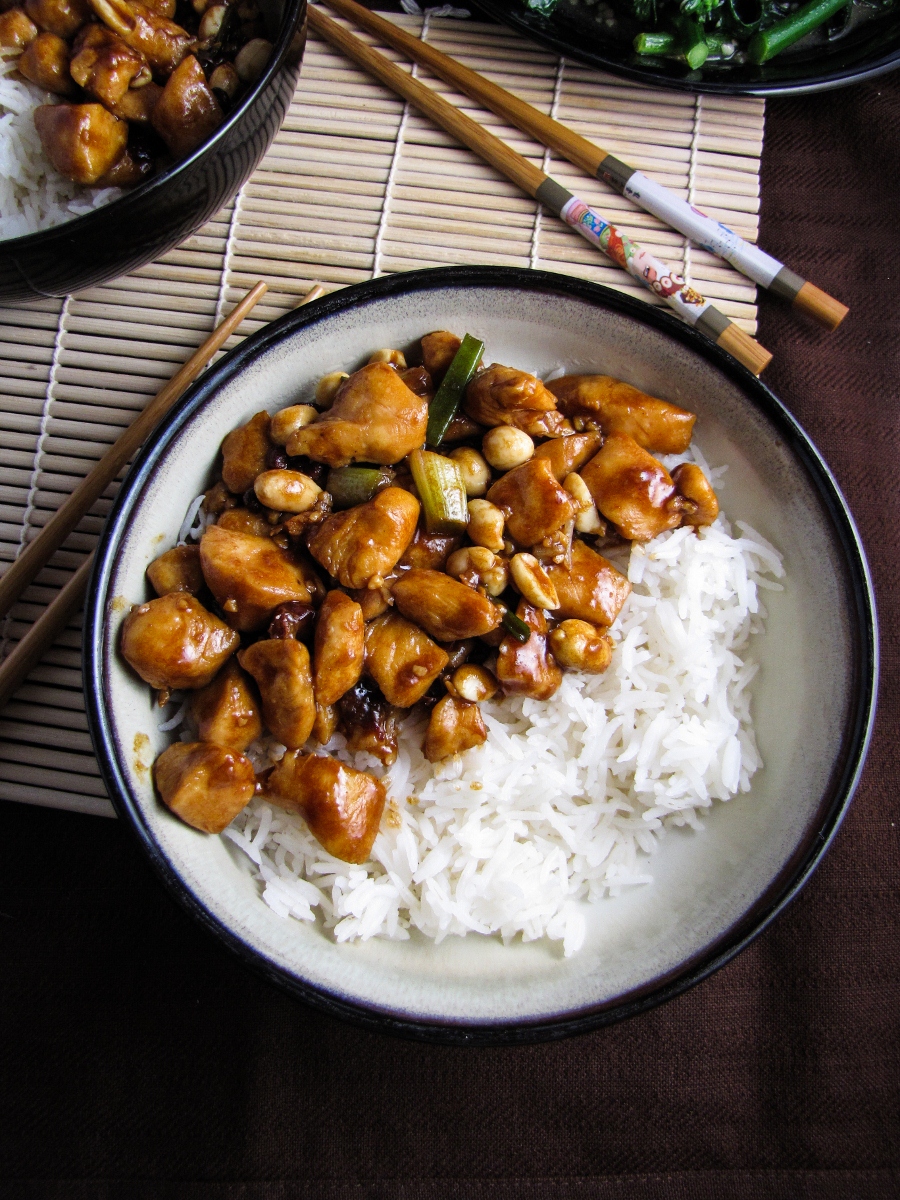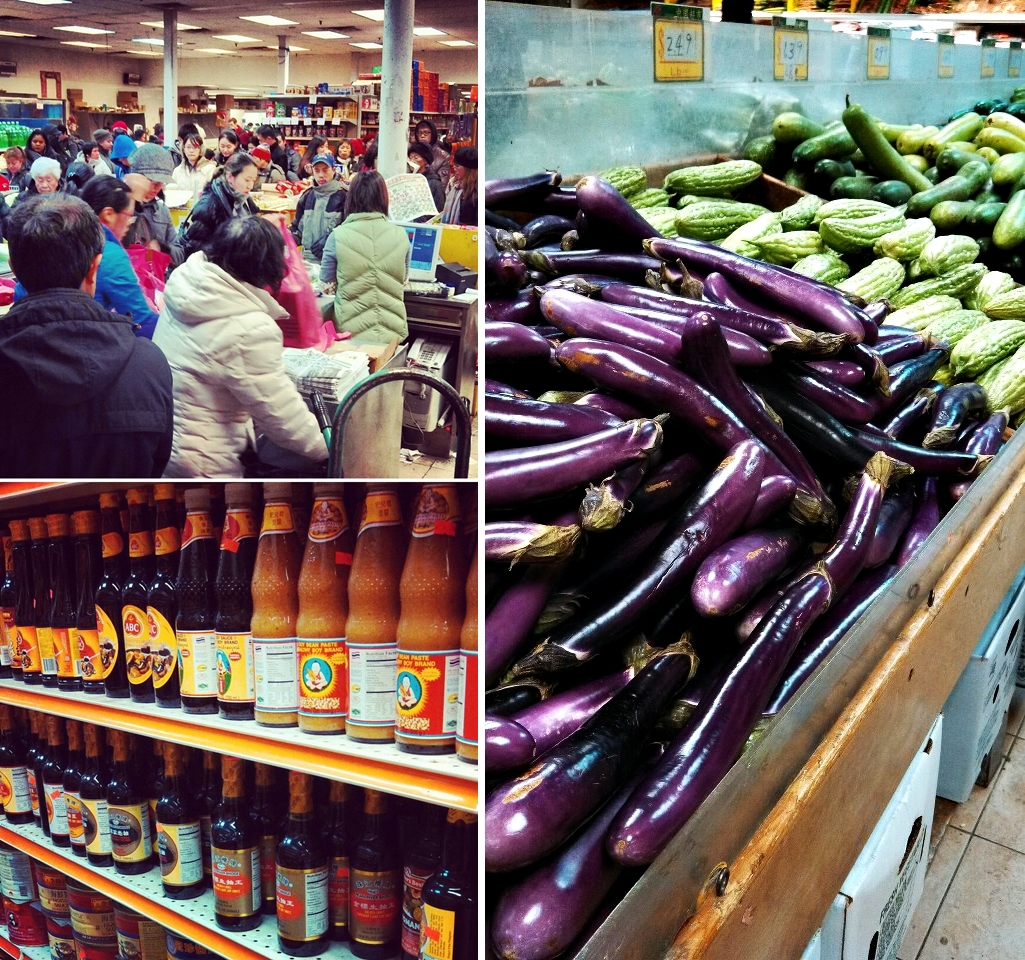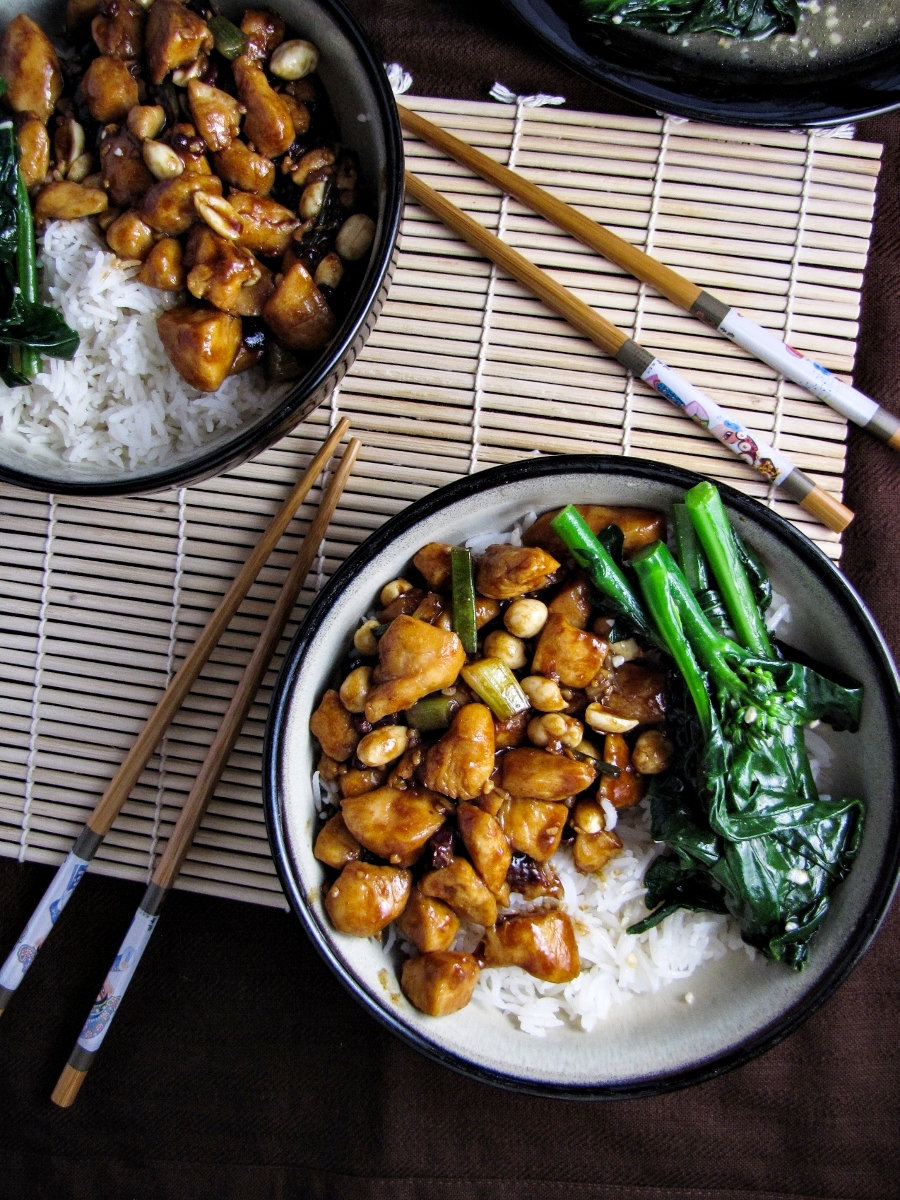I’ve always been a bit of a bookworm. When I was at the height of my reading-frenzy, which was probably 4th or 5th grade, I used to keep lists of every book I read during the year, and in the summer, I’d frequently go through multiple books a day. Chapter books, of course. Now, a lot of my book time is spent with cookbooks, although don’t be surprised if you find me sitting on the floor in the used paperback section at the bookstore, a stack of 9 books I want to buy at my side. Because I had so much fun writing cookbook reviews this fall, I’ve decided to make it a more regular feature here. Hopefully, weekly, although I’m not off to a good start, given that I planned to post this on Thursday… I’m blaming blizzard preparations. So I bring you “Book Club,” a column that will feature mostly newly released cookbooks, sometimes old cookbooks, and occasionally great fiction or non-fiction I’ve been reading on the side. I hope you enjoy it!
First up is Every Grain of Rice: Simple Chinese Home Cooking, a book by Fuchsia Dunlop, which was just released on Monday. This is Fuchsia’s 3rd cookbook focused on Chinese cuisine – she is also the author of Land of Plenty: A Treasury of Authentic Sichuan Cooking and of Revolutionary Chinese Cooking: Recipes from Hunan Province. In addition, she wrote the memoir Shark’s Fin and Sichuan Pepper detailing her food-driven journeys through China. Although not ethnically Chinese, Fuchsia certainly knows the ins and outs of Chinese cooking better than most.
Every Grain of Rice is a solid cookbook. It starts with an introduction to Chinese ingredients, utensils, and techniques, and quickly moves into recipes organized by main ingredient – tofu, leafy greens, chicken & eggs, root vegetables, mushrooms, noodles, dumplings, etc. Every recipe has a lengthy headnote, often describing the history or cultural importance of the dish, as well as the flavor and any adaptations you can make. I’m a big fan of good headnotes – when you’re confronted with a book full of a hundred recipes, it makes it so much easier to know what recipe to choose! Almost every recipe also has a beautiful, clean, full-page photograph to go with it. The photographic style is simple and bright, perfectly reflecting the food it depicts.
As I started flipping through the recipes, one of my first thoughts was: “This is how Rongjie eats.” Rongjie is my friend/co-worker who sits across from me at work. Both she and her roommate are Chinese, and everyday she brings in a lunch that one of them has made consisting of rice, some sort of dark and saucy meat or tofu dish, and dark leafy greens. It’s very different from how I eat, but also very healthy. I decided that for my recipe testing for this book, I would try and emulate this typical Chinese way of eating, by making Gong Bao Chicken, served with Chinese Broccoli in Ginger Sauce and plain rice. And this is where things got interesting.
One challenge of Chinese cooking is that you need Chinese ingredients – which can be hard to find, depending on where you live. Since I’m fairly unfamiliar with Chinese cooking, I brought in a list of the ingredients I needed to show Rongjie and to pick her brain on what they were like, and what might be good substitutes if I could’t find them. Her suggestion? Just go to Chinatown. But I didn’t want to go by myself, so I coerced her into coming with me to show me where to go, which is how both of us ended up in an insanely crowded Chinese grocery store, two hours before the MBTA shut down for the blizzard, and two days before Chinese New Year. INSANE. But really exciting. I was super over-stimulated in there – rows and rows of bright and unfamiliar ingredients, being pushed on all sides by tiny old Chinese ladies, the smell of fish in the air, occasional announcements in Chinese that seemed to cause quite a stir among the other shoppers… it was an experience. But I got what I needed – dark soy sauce, Shaoxing wine, Chinkiang vinegar, potato starch, and Chinese broccoli.
When I got home, snow swirling outside, I was ready to start cooking. But after all that adventuring, I discovered that both my garlic and my ginger had somehow managed to go bad. Sigh. I went forward anyways, borrowing minced garlic and using dried ginger instead. Not as authentic as I wanted, but both dishes still tasted great, so it was all OK. The chicken in particular was delicious – sweet, salty, and spicy, with a thick tangy sauce, it was as good as any Chinese takeout I’ve had. And since I have massive bottles of soy sauce, wine, and vinegar leftover, I’m excited to start trying some of the other recipes – like Stir-Fried Beef with Black Bean and Chili, General Tso’s Chicken, and Buckwheat Noodles with Red-Braised Beef. The real test of any of these dishes, though, will be when I bring the leftovers in for lunch and get Rongjie’s expert opinion. If she has any comments, I’ll report back.
The bottom line: Every Grain of Rice is a solid cookbook that serves as a great introduction to simple Chinese cooking. Based on my limited knowledge of Chinese cuisine, the recipes seem authentic, and the few that I’ve tried have been delicious. Cooking from the book will require an investment in a few special ingredients, but once you have the basics, you’ll be able to cook most of the recipes in the book. From a design standpoint, Every Grain of Rice is clean and well organized, with plenty of beautiful full-page photographs. I’d recommend this to anyone who likes eating Chinese food, or who is interested in learning a new cuisine.
Disclaimer: I was sent a free review copy of Every Grain of Rice by the publisher, W.W. Norton, but I was not otherwise compensated to write this review and all opinions are my own!
Gong Bao Chicken with Peanuts
Reprinted from Every Grain of Rice: Simple Chinese Home Cooking by Fuchsia Dunlop. Copyright © 2012 by Fuchsia Dunlop. With the permission of the publisher, W.W. Norton & Company.
- 2 boneless chicken breasts, with or without skin (11–12 oz/300–350g in total)
- 3 garlic cloves
- An equivalent amount of ginger
- 5 spring onions, white parts only
- A handful of mild dried chillies (about 10)
- 2 tbsp cooking oil
- 1 tsp whole Sichuan pepper
- 3 oz (75g) roasted peanuts
For the marinade:
- 1/2 tsp salt
- 2 tsp light soy sauce
- 1 tsp Shaoxing wine
- 11/2 tsp potato flour
For the sauce:
- 1 tbsp sugar
- 3/4 tsp potato flour
- 1 tsp dark soy sauce
- 1 tsp light soy sauce
- 1 tbsp Chinkiang vinegar
- 1 tsp sesame oil
- 1 tbsp chicken stock or water
- Cut the chicken as evenly as possible into 1/2 in (11/2cm) strips, then cut these into small cubes. Place in a small bowl. Add the marinade ingredients together with 1 tbsp water, mix well and set aside while you prepare the other ingredients.
- Peel and thinly slice the garlic and ginger and chop the spring onions into chunks as long as their diameter (to match the chicken cubes). Snip the chillies in half or into sections. Discard their seeds as far as possible. Combine the sauce ingredients in a small bowl.
- Heat a seasoned wok [or frying pan] over a high flame. Add the oil with the chillies and Sichuan pepper and stir-fry briefly until the chillies are darkening but not burned (remove the wok from the heat if necessary to prevent overheating). Quickly add the chicken and stir-fry over a high flame, stirring constantly. As soon as the chicken cubes have separated, add the ginger, garlic and spring onions and continue to stir-fry until they are fragrant and the meat just cooked through (test one of the larger pieces to make sure).
- Give the sauce a stir and add it to the wok, continuing to stir and toss. As soon as the sauce has become thick and shiny, add the peanuts, stir them in and serve.
Chinese Broccoli in Ginger Sauce
Reprinted from Every Grain of Rice: Simple Chinese Home Cooking by Fuchsia Dunlop. Copyright © 2012 by Fuchsia Dunlop. With the permission of the publisher, W.W. Norton & Company.
- 3/4 lb (350g) Chinese broccoli
- Salt
- 4 tbsp cooking oil
- 2 tbsp finely chopped ginger
- 1 tbsp Shaoxing wine
- 1/2 tsp sugar
- 1 tsp potato flour mixed with 1 tbsp cold water (optional)
- Bring a large panful of water to a boil (a generous 21/2 quarts/21/2 liters will do). Wash and trim the Chinese broccoli. If the lower parts of the stems are thick and fibrous, peel away their outer skin with a potato peeler.
- When the water is boiling, add 1 tbsp salt and 1 tbsp oil, then the Chinese broccoli. Blanch it for a minute or two to “break its rawness.” The stems should be just tender, but still crisp. If you are stir-frying them immediately, simply drain the broccoli stems and shake dry in a colander; if you want to serve them later, refresh the stems under a cold tap to arrest cooking before draining well.
- When you wish to serve the broccoli, add the remaining oil to a seasoned wok over a high flame, swirl it around, then add the ginger and sizzle briefly until you can smell its fragrance. Splash in the Shaoxing wine and add the sugar. Add the broccoli and stir-fry, adding salt to taste, until it is piping hot. (If you are using broccoli blanched earlier, then cooled, you will need to pour 2–3 tbsp water or stock into the wok and cover it, so the stems reheat thoroughly.)
- Remove the stems from the wok and lay them neatly on a serving dish. If you wish to thicken the juices, give the potato flour mixture a stir and add just enough, in stages, to thicken the sauce to a clingy consistency; then pour the sauce over the broccoli and serve. If you do not wish to thicken the juices, simply pour them and the ginger over the broccoli.







These photographs qualify as just plain food porn ! :-) I live about an hour from St. Louis, MO and have no idea where I’m going to find Chinese ingredients. I sense a serious Google search coming. Thank you for all this gorgeous stuff, recipes included. I love your blog and all the things I am learning from you. I hope you don’t have a hard time with this ridiculous storm.
Well thanks, Jack! If it helps, before I had committed to hitting up Chinatown, I made it this far with my substitution list: Balsamic vinegar for the Chinkiang vinegar, Sherry for the Shaoxing wine, cornstarch for the potato starch, and spinach for the Chinese broccoli. My friend says there’s no good substitute for dark soy sauce, though… Thanks for reading!
the chinkiang vinegar and shaoxing wine is what gives the dish its signature moreish heavenly taste, substituting with balsamic and sherry will make it taste like generic gloopy careless takeaways with a funny balsamic flavour, ok for emergencies but not if you want something lip smacking. Dark soy is used for coloring, ( ie make it look dark brown) it should be the least of anyone’s worries. A high quality Tamari from a health food store is in fact an improvement on dark soy.
Amazing photos & I love your idea of cook book reviews. Looking forward to your future postings
Yay, I’m glad! It’s always nice when someone besides me is interested in what I’m writing…
From one former bookworm and list-maker to another: Nice review. Great photos, too. And may you never run out of garlic and ginger again!
What an inspiring blog, which I am definitely going to follow every day!
I love this post with your Gong Bao Chicken (Gong Bao Ji Ding). It looks very delicious, and I will try to make this some time. I have not yet found a good recipe for this since I returned from China, but your dish looks so good that I simply have to try it.
Keep up the wonderful work and your pictures are amazing.
Many greetings from Elena.
Your photos are so beautiful! I love your style!
Firstly – that looks delicious and I am starving. Secondly – I’m excited that you have decided to bring back reviews! I always love a good cookbook review.
Beautiful. This is making me so hungry!! I’ve never cooked with Chinese broccoli but it looks amazing.
Oh, we just made Daube Provençale (again!) from an earlier post. Yum. And this recipe looks great too. I wonder if you know–or could even offer an opinion– on how to make the Gong Bao Chicken…..withOUT Peanuts? I am so very allergic to them. And I might substitute tofu, except that maybe the peanuts add a specific texture or flavor or seasoning that is important? Thanks for any suggestions. And keep up the book reviews. I’m an addicted cookbook reader from way back!
Hi Aine – I’m so glad you’re enjoying the recipes! You could definitely take the peanuts out of this without too much of an impact. They do add a nice crunch, so if there’s another nut that you’re not allergic to, they might be a good substitute – cashews come to mind. If nuts are a no-go, you could try just sprinkling something else a little crunchy on top – maybe sesame seeds? Let me know what you try!
Broccoli Rabe would be a good substitute for the Chinese Broccoli, if a substitute is needed. The photos are wonderful, and I think I can smell the Chicken in my near future. Thank you so much for being out there!
Wow your blog is very nice. I am a student of translation, and thinking about translating this book into Chinese as one of my graduation project. Anyway, hope you could have a wonderful time to enjoy Chinese food!^^
“substituting with balsamic and sherry will make it taste like generic gloopy careless takeaways with a funny balsamic flavour” I totally disagree with the comment above.
Balsamic vinegar from general stores is just white wine vinegar with added caramel and colouring. The real balsamic vinegar is totally different and I doubt it’s what you’ve used anyway. The chinkiang vinegar sold in Chinese stores are generally the lowest grade stuff and to be honest is very similar to the cheap “balsamic”. Shaoxing wine sold in Chinese stores are again not always the best grade and I even had one that had a funny sour after taste. A good, very dry (must be the very dry variety) sherry is very similar to a top grade Shaoxing wine therefore is a much better alternative. Another thing: Gong Bao chicken was originally from Guizhou/Sichuan whereas chinkiang vinegar is from south Jiangsu and shaoxing wine from north Zhejiang. You’re talking about southwest vs east coast of China! I doubt the original dish would use ingredients that far away anyway. They were more likely to use a local variety of rice wine and rice vinegar. It’s funny how nowadays people think chinkiang vinegar and shaoxing wine are store cupboard essentials whereas in China, people would use local varieties. In the North, people would use vinegar from Shanxi. As for wine, lots of people from other region would use a generic low grade “cooking rice wine”, not necessarily shaoxing wine.
What makes a dish taste good is the heat and timing which is difficult to describe in a recipe. If you cook it right the substitution of vinegar or wine is unlikely to make big difference. I doubt takeaways would use sherry anyway as sherry is more expensive! So is the “cheap” balsamic vinegar! The problem with gloopy takeaway is not the ingredients but how they cooked it!
The only substitution you shouldn’t have made is the ginger. Powdered ginger does not belong to a Chinese kitchen. There is no alternative!
As for soy sauce, Fuchsia suggests tamari soy sauce but it’s not made in the same way as Chinese soy sauce (believe me, Japanese and Chinese soy sauce are different). I would choose a good, naturally brewed Taiwanese brand. Dark soy sauce is mainly for colouring so should only be needed occasionally if you normally use light soy sauce for flavouring. If you use the naturally brewed Taiwanese soy sauce, you won’t need dark soy sauce at all.
This book is really authentic (not seems to be). It’s the best one on the market for real Chinese food. I haven’t yet found another one (not written by Fuchsia) that’s as close to what Chinese people actually eat daily.
What a really insightful (and helpful!) comment. Thank you! You’re obviously very well versed in the ingredients and history of Chinese cooking… I will keep all of this in mind the next time I’m shopping for a Chinese recipe :-)